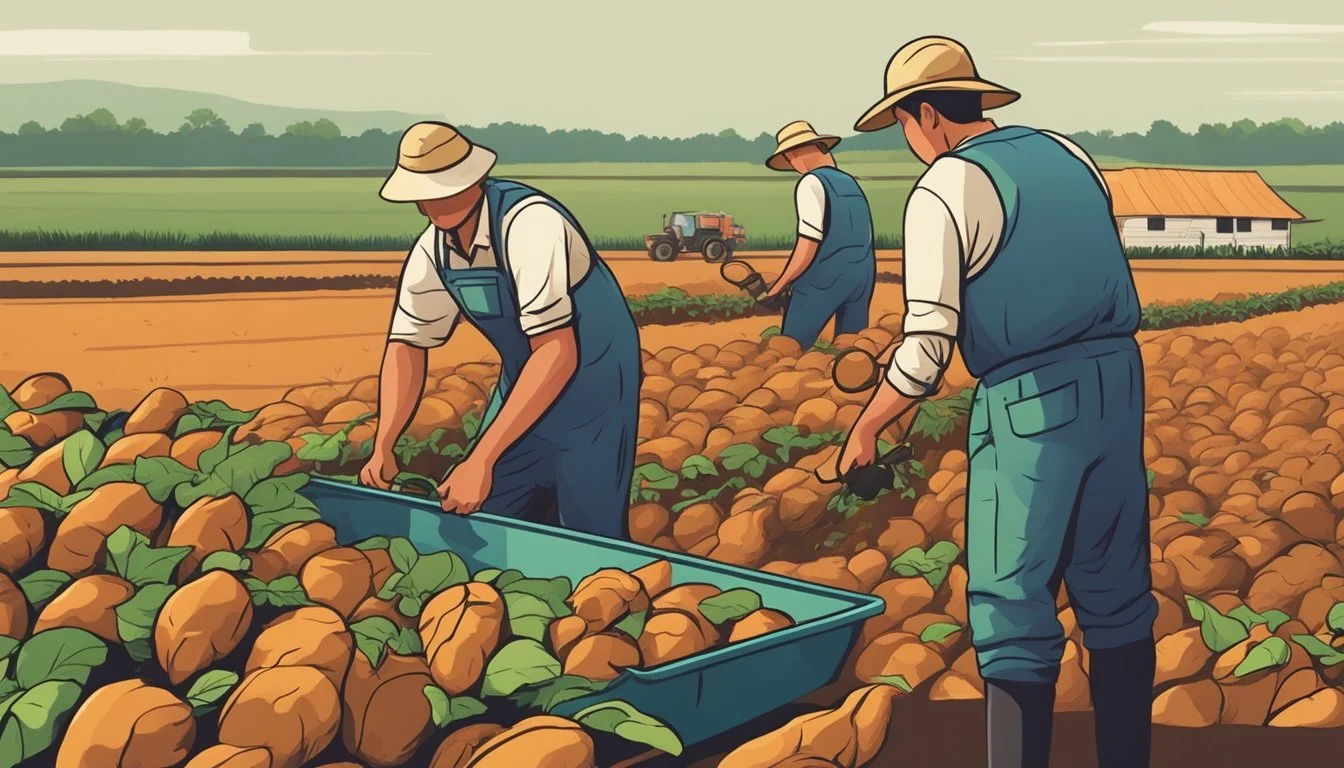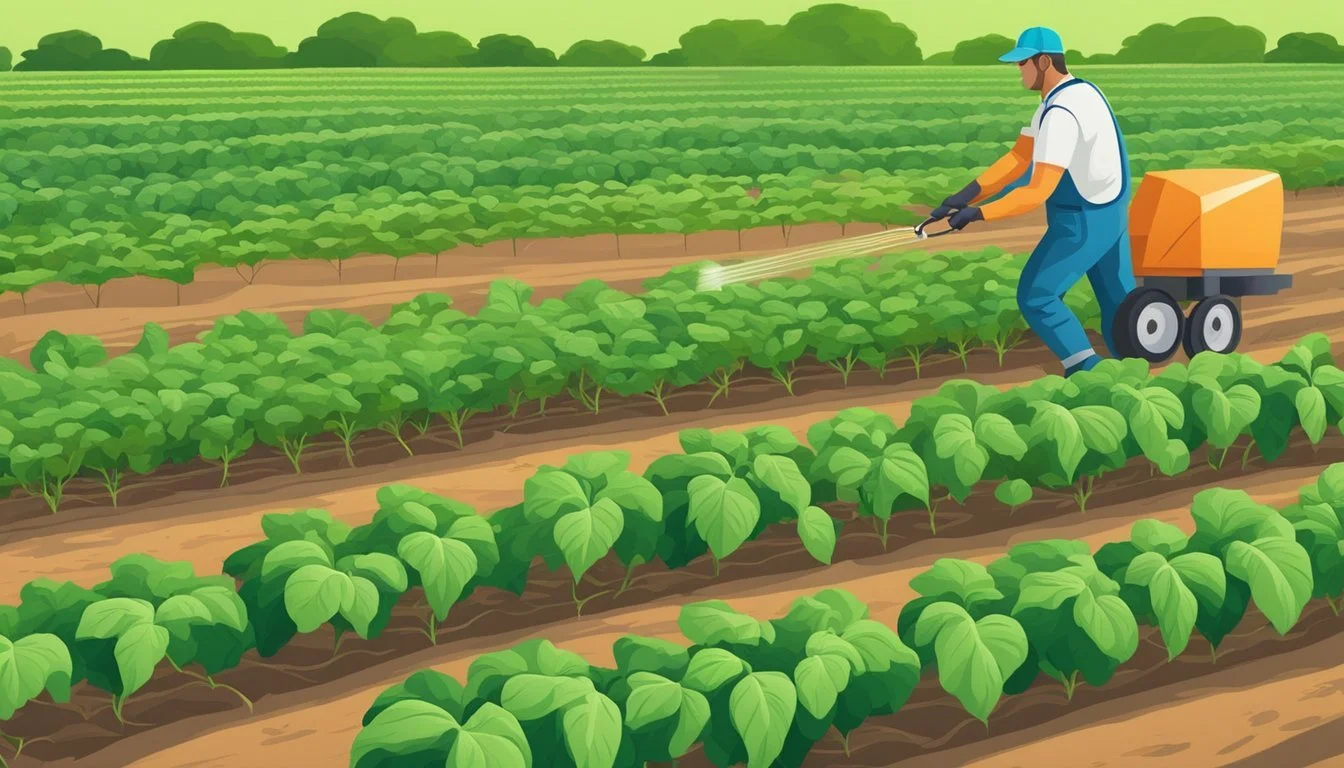Pest Control for Sweet Potatoes
Effective Strategies for Healthy Crops
Sweet potatoes (What wine goes well with potatoes?) are a nutritious and versatile crop enjoyed around the globe, but like many plants, they can be susceptible to a variety of insects and diseases that can affect both yield and quality. Effective pest management is critical for maintaining healthy sweet potato crops. It requires an understanding of the pests that typically affect sweet potatoes (What wine goes well with sweet potatoes?), the damage they cause, and the methods available for control. One of the most notorious pests is the sweet potato weevil, which attacks the plant at both the larval and adult stages, leading to significant crop loss if not properly managed.
Integrated Pest Management (IPM) strategies are widely recommended for sweet potato crops. This approach combines various techniques to manage pests in an economically and ecologically sound manner. Essential measures include crop rotation to disrupt pest life cycles, proper field sanitation to remove potential breeding grounds, and the judicious use of insecticides when necessary. Another important practice is providing adequate spacing between plants to promote good air circulation, which can help minimize the onset of diseases and infestations.
Understanding the pests' life cycle is pivotal for timing control measures effectively. Soil-inhabiting pests can be particularly challenging as they directly affect the tubers, the edible part of the plant, making early detection and control imperative. Not all regions face the same pest pressures; for instance, the sweet potato weevil is a major concern in Florida, while the sweet potato flea beetle is more common in North Carolina. Therefore, specific pest control practices may vary depending on the prevalent pests in a region.
Understanding Sweet Potato Pests
Sweet potatoes are subject to various pests that can significantly affect yield and quality. Recognizing and managing these pests is essential for successful cultivation.
Insect Pests: Pests like the sweet potato weevil and sweetpotato flea beetle are primary concerns for growers. The weevil's larvae bore tunnels into the sweet potato, leading to infestation and decay. Similarly, whiteflies and aphids can transmit viruses detrimental to the crop.
Table 1: Common Sweet Potato Pests and Impact
Pests Impact on Sweet Potatoes Sweet potato weevil Creates tunnels, causes decay Sweetpotato flea beetle Leads to defoliation, lower crop quality Aphids Can transmit harmful viruses Whiteflies Spread sweet potato whitefly-transmitted viruses
Nematodes: Beyond insects, nematodes like the root-knot nematode can cause galls or swellings on roots, affecting the plant's nutrient uptake.
Cultural Practices: Effective management includes cultural practices, such as crop rotation and sanitation, to minimize pest presence. Additionally, the use of predators and beneficial nematodes can help manage white grubs and whitefringed beetle larvae.
Diseases: Insects contribute to the spread of diseases, with some like the whitefly transmitting viruses that lead to diseases in sweet potatoes. Managing insect pests thus also aids in reducing the incidence of such diseases.
Conclusion: Vigilance in monitoring and addressing the onset of pests—through a combination of practices—is crucial to safeguard the sweet potato crop from damage and loss.
Cultivation and Pest Management
Effective cultivation and pest management are essential for optimizing sweet potato yields and quality. Incorporating crop rotation, selecting resistant varieties, and implementing an Integrated Pest Management (IPM) strategy are crucial for reducing the impact of pests and diseases.
Crop Rotation and Sanitation
Crop Rotation:
Improves soil health and disrupts pest life cycles.
Reduces incidences of nematodes and soil-borne diseases.
Sanitation:
Involves removing plant debris and weeds that can harbor pests.
Essential for minimizing economic loss due to pest damage.
Resistant Varieties
Sweet potato varieties that are resistant to common pests and diseases, such as the sweet potato weevil and certain viruses, can be planted.
These varieties help reduce reliance on pesticides and enhance the effectiveness of cultural practices.
Integrated Pest Management
IPM is a holistic approach that combines multiple practices:
Monitoring crops regularly for pest activity.
Using beneficial insects like lacewings and parasites to control pest populations.
Applying biological control methods and site-specific pesticides when necessary.
Incorporates the use of natural predators and cultural practices to maintain pest damage below economic thresholds.
Encourages the use of neem oil and other less invasive options before resorting to conventional pesticides.
Pest Identification and Control Strategies
Effective pest management is crucial for maintaining a healthy sweet potato crop. This section explores various strategies, identifying key pests, and considers economic and environmental impacts.
Insect Pests and Diseases
Sweet potato crops are susceptible to various insect pests such as the sweet potato weevil, sweet potato flea beetle, sweet potato aphid, and sweet potato whitefly. These pests can cause significant damage to the vines and tubers of the sweet potato plants. Diseases like soft rot, sweet potato leaf curl virus, and sweet potato feathery mottle virus also threaten the yield and quality of the crop. Effective identification of these pests and diseases is the first step in implementing control measures.
Natural Predators and Biological Controls
Natural predators such as ladybugs and parasites are beneficial insects that can control the population of harmful pests on sweet potato plants. The use of biological control, which involves introducing or encouraging these natural predators, can reduce the reliance on chemical pesticides. For example, introducing certain species of mites that prey on whiteflies can be an effective biological control strategy.
Chemical Controls
When natural methods are insufficient, chemical controls can be employed. Soil insecticides and granular insecticides are commonly used against soil-dwelling pests. However, chemicals such as spinosad and malathion should be used responsibly as part of an integrated pest management approach to minimize environmental impact and the development of pesticide-resistant varieties of pests.
Mechanical and Cultural Controls
Mechanical and cultural controls include practices like tillage, crop rotation, and sanitation to disrupt the life cycle of pests. These methods can significantly reduce the presence of soil insects and disease agents. Utilizing reflective mulch can deter aphids and whiteflies from settling on sweet potato plants and is another example of a cultural control method that promotes a more productive crop without chemical intervention.
Environmental and Economic Considerations
The choice of pest control methods should weigh both environmental and economic considerations. Chemical treatments can lead to economic loss if not managed correctly, as they may affect the marketability of the crop. Conversely, unchecked pest issues can decrease yields and the viability of a productive crop. Integrated pest management strategies that combine biological, cultural, and chemical methods can optimize pest control while minimizing negative environmental impacts.
Harvesting and Post-Harvest Treatments
The quality and marketability of sweet potatoes heavily rely on the methods used during harvesting and the treatments applied post-harvest to prevent infestation and loss.
Effective Harvesting Practices
When harvesting sweet potatoes, it's crucial to avoid damaging the tubers, as cuts and bruises can decrease their marketability and increase the risk of disease. Deep plowing is recommended to loosen the soil and reduce the risk of damaging the tubers during harvest. Harvesting should be performed in dry conditions, as wet soil can complicate the process and potentially harm the sweet potatoes. It's also advisable to use certified transplants and to ensure that any planting material is not infected to prevent future pest problems.
Postharvest Pest Management
Applying postharvest treatments to sweet potatoes is essential to maintain quality and prevent economic loss due to infestation. At harvest time, sweet potatoes should be dusted with an appropriate insecticide, like 5% Imidan dust, using a recirculating duster for thorough coverage to combat sweet potato weevils. Following harvest, proper sanitation measures, including prompt removal of infected or damaged tubers from storage and use of disease-resistant varieties, can help in managing pests and diseases. Crop rotation is an important strategy that minimizes recurring infestations by breaking the life cycle of pests.
Conclusion
Effective pest management is crucial for maintaining a healthy and productive sweet potato crop. Regular monitoring and implementation of integrated pest management practices can significantly reduce the damage caused by common sweet potato pests such as the sweet potato weevil, cutworms, and various diseases.
Preventative Measures
Sanitation
Use of disease-resistant varieties
Monitoring
Regular inspection of crops
Identification of pests and diseases early in their life cycle
Control Measures
Organic pest control methods where appropriate
Insecticides like Sevin for pests such as cutworms, when necessary
Farmers and gardeners should prioritize early intervention, which can be more effective and less costly than addressing a full-blown infestation. Combining cultural practices with targeted treatments allows for a sustainable approach to pest control. Practices such as regular monitoring and using integrated pest management techniques can lead to a healthy crop with minimized use of chemicals.
It is important to remember that no single control method is foolproof. Therefore, comprehensive strategies adapted to local conditions and specific pest pressures tend to be most effective in securing sweet potato yield and quality.
Frequently Asked Questions
In addressing the challenge of pests in sweet potato cultivation, it is essential to understand the common pests, methods for managing weevils, natural pest control remedies, recommended insecticides, preventative measures, and the role of neem oil.
What are the most common pests that affect sweet potato plants?
Sweet potato plants can be affected by a range of pests, among which soil insects such as sweet potato weevils, rootworms, wireworms, white grubs, and flea beetles are predominant. These pests damage the plants by feeding on the tubers or foliage.
How can I identify and manage sweet potato weevils?
The sweet potato weevil is a small beetle that can be identified by its elongated snout and can cause extensive damage to the crop. Management strategies include using pheromone traps, rotating crops, and applying insecticides specifically labeled for weevils.
What natural remedies are effective for controlling pests on sweet potatoes?
Effective natural remedies for controlling pests on sweet potatoes include crop rotation and providing adequate spacing between plants to promote air circulation, which helps minimize pest infestations and the spread of disease.
Which insecticides are recommended for tackling sweet potato beetle infestations?
When tackling sweet potato beetle infestations, farmers should consider insecticides that are specifically approved for managing insect pests of sweet potato. It is important to read the current product labels carefully for application rates and active ingredients before use.
What steps can I take to prevent sweet potato diseases and pests?
Preventative steps to protect sweet potatoes from diseases and pests include practicing crop rotation, ensuring good air circulation through sufficient plant spacing, and regular monitoring of the crop for early detection of potential problems.
How can neem oil be used in pest management for sweet potatoes?
Neem oil is an organic option that can be used in managing sweet potato pests. It acts as a repellent and also interferes with the life cycle of pests upon application to the foliage or soil around the sweet potato plants.





